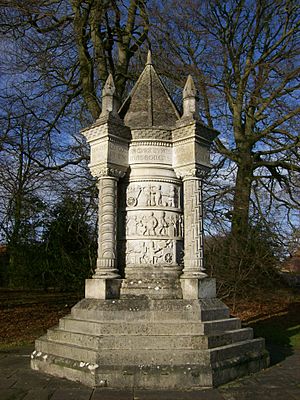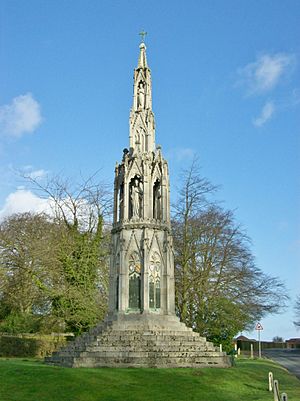Wagoners' Memorial facts for kids
The Wagoners' Memorial is a special war memorial located in Sledmere, a village in the East Riding of Yorkshire in England. It looks like a short, strong stone column. Sir Mark Sykes, 6th Baronet designed it, and it was built between 1919 and 1920. This memorial is very important, so it was first listed as a Grade II building in 1966 and then upgraded to Grade I in 2016. It stands close to the Eleanor Cross, Sledmere, which is another memorial that Sir Mark Sykes also turned into a war memorial for the men from his estate.
Contents
Who Was Sir Mark Sykes?
Sir Mark Sykes was an important person who created the Wagoners' Memorial. He was the son of another important figure, Sir Tatton Sykes, 5th Baronet. Mark Sykes served in the military, first in the Boer War and later as a lieutenant colonel in the 5th Battalion of the Yorkshire Regiment. He was also a Member of Parliament (MP) for Kingston upon Hull Central from 1911 until he passed away in 1919. He became a baronet (a special title) when his father died in 1913.
The Wagoners' Special Reserve
In 1912, Sir Mark Sykes got permission to create a special group called the Wagoners Special Reserve. This was part of the Territorial Army. He recruited farm workers and farmers from across the Yorkshire Wolds to join. Their job was to drive horse-drawn wagons if there was a war. Sykes even held competitions for his wagoners to show off their driving skills!
Wagoners in World War I
When World War I started, 1,127 men from the Wagoners' Reserve were called up to serve. They joined units like the Royal Army Service Corps and the Royal Engineers. Most of them went to the Western Front in France. Even though they had little military training, they had a very important job: moving essential supplies like food, ammunition, and equipment. Wagoners also served in other places like Italy, Salonika, and the Middle East.
Sadly, Sir Mark Sykes became ill with the Spanish flu while attending a peace conference in Paris in 1919. He died before the memorial he designed was finished.
About the Memorial Itself
The Wagoners' Memorial is located on the west side of Sledmere, near St Mary's Church and Sledmere House, which was Sykes' home. Sir Mark Sykes designed it himself. People say he based his design on an old Saxon memorial found in the crypt of York Minster.
What the Memorial Looks Like
The memorial is about 6 feet (1.8 meters) tall. It has an eight-sided base with five steps leading up to a short stone column. This column is made of Portland stone and has many stone carvings. It has a cone-shaped top and a pointed part called a pinnacle, which once had a cross on it (but the cross is now gone).
Four thinner columns surround the main central column. These support a carved stone band with an inscription (words) on it. Alfred Barr built the stone parts, and Carlo Domenico Magnoni created the sculptures. These sculptures are like simple, folk art. They wrap around the central column in three sections, similar to the famous Trajan's Column. They show scenes from the Wagoners' history:
- Sykes recruiting them.
- Them being called up for war.
- Their journey to France.
- Scenes of conflict.
A famous art historian named Nikolaus Pevsner described the memorial as "curiously homely," meaning it felt very simple and comforting. The memorial also has a five-verse poem written in the local dialect.
Unveiling the Memorial
The Wagoners' Memorial was officially revealed on September 5, 1920. Sir Ivor Maxse, a high-ranking general, led the ceremony. About 2,000 people came to watch, and there was a special guard of honor from the 5th Battalion, Yorkshire Regiment. The last veteran who served as a wagoner passed away in 1993.
Images for kids





